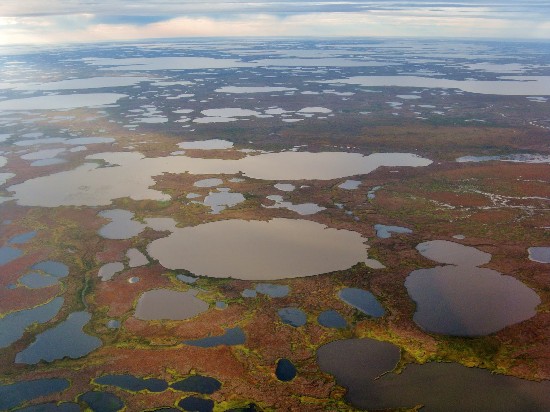In the latest Bloomberg Green Daily, Eric Roston’s Climate Report describes what he calls a haywire consequence of atmospheric warming, “frozen land on fire.”
What is he talking about? Permafrost in the frozen Arctic is increasingly being destabilized as polar atmospheric temperatures rise. The result is changes to the Arctic landscape as thawing leads to a phenomenon described as thermokarst acceleration. What does that mean?
Thermokarst describes a landscape found in the Arctic that features pothole lakes of meltwater, and small hummocks of vegetation lying over partially frozen subsurfaces. What accompanies thermokarst acceleration is atmospheric warming.
A study published in One Earth this month describes the spread of thermokarst landscapes in the Alaskan Arctic stating it has accelerated 60% since 1950. And along with the landscape change is accompanying wildfire outbreaks further contributing to thermokarst acceleration. The trend has been ongoing for the past seventy years and is speeding up.
Global climate models show us that what happens with anthropogenic climate change in the mid-latitudes gets exaggerated further as we move poleward. This is particularly true in the Northern Hemisphere with its large landmasses surrounding the small largely ice-covered Arctic Ocean.
The latest IPCC report tells us that global mean temperatures have risen 1.1 Celsius since the dawn of the Industrial Revolution. That increase, however, is not uniform across the planet. Over oceans, the mean rise has been 0.8 Celsius. Over continents, it is surpassing 1.5. Here in Toronto at 43.6 degrees latitude and not quite halfway to the North Pole, we have warmed 1.8 degrees. In the Arctic, that rise is threefold greater.
Alaska, the Yukon, Northwest Territories, Nunavut, the Scandinavian countries, and Siberia have all been seeing record warmth and subsequently have been witnessing permafrost melt acceleration with the spread of thermokarst landscapes featuring ground subsidence, meltwater pothole lakes, slightly elevated areas covered by peat, small bushes and stunted trees (see the image at the top of this article). Underlying the landscape is partially melted permafrost, a semi-frozen mix of soil and rock containing vast amounts of biomass.
This partially thawed biomass is turning out to be a perfect breeding ground for microbes. And where there are microbes there is outgassing. In this case, lots of methane, the same gas SpaceX uses as fuel for its Falcon 9 rockets. Methane releases from microbe exhalations accelerate local atmospheric warming. And with the highly inflammable gas in proximity to tinder-dry surface vegetation, it is no wonder that wildfire outbreaks are on the rise in the Arctic with long-term consequences for the landscape that contribute to its increasing thermokarst appearance.
The One Earth published study is just another example of what climatologists have been saying for several decades. Two years ago, a University of Alaska Fairbanks research study that appeared in Geophysical Research Letters stated that Canadian Arctic permafrost was thawing 70 years earlier than predicted, describing it as a canary in the climate change coal mine.
When permafrost melt accelerates, climate scientists describe it as a potential tipping point for climate change. The heat-trapping methane gas when released into the atmosphere causes short-term spikes in temperature that can last a few decades. That’s because methane breaks down in the atmosphere in eight to twelve years. But while it is around it is 80 times more potent in trapping heat than carbon dioxide (CO2). And unlike CO2, methane is inflammable which makes it fuel for wildfires. Methane, along with atmospheric lightning strikes and human carelessness is a recipe for Arctic wildfires and they are happening in increasing amounts.
Just how impactful are the fires in the Arctic? This year saw record-breaking outbreaks in Siberia. One June event alone covered more than 50,000 square kilometres (19,300 square miles) and consumed both boreal forest and wetlands lying atop permafrost. The plumes of smoke from this one fire contributed 188 megatons of CO2 and particulate matter to the atmosphere, depositing sooty residue on nearby sea ice accelerating its melting. This one fire would have been tragedy enough, but Siberia experienced others over two-and-a-half months of spring and summer with the total amount of emitted CO2 greater than that produced by Germany in a year, the sixth most polluting country on the planet. And one thing more, a characteristic of Arctic fires that invade drying peat wetlands is they often don’t go out and continue to burn through the biomass below the surface. When gone, they leave a scar on the land that can take hundreds of years to heal. If that’s not a description that sets off alarms, I don’t know what is.
















